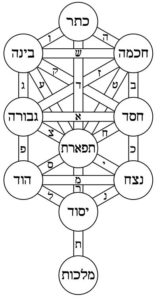Who was Og and how did he survive the Great Flood? What exactly were the Ten Trials of Abraham?What is the difference between Chokhmah, Binah, and Da’at (“Chabad”)? Which of the “Cosmic Shemittot” are we in? Where was the Garden of Eden? Find out the answers to these and other big questions in Sefer Beresheet:
Tag Archives: Da’at
A Mystical Peek Into Megillat Esther
Purim is a deeply mystical holiday. In fact, Megillat Esther literally means “revealing the hidden”. While God is not explicitly mentioned anywhere in the Scroll, His fingerprints can be found all over it. In the same way, the Megillah is imbued with tremendous hidden wisdom. That it has a total of 10 chapters is the first clue, and if you read carefully, you will find that just about every Sefirah is mentioned!
 The first Sefirah is Keter, the great “Crown” of God, and the first chapter of the Megillah is all about highlighting the greatness of Achashverosh’s crown and kingdom. Our Sages taught that Achashverosh wished to dress in the vestments of the kohen gadol, to “crown” himself as a king of the Jews (Megillah 12a). As is well-known, it was also taught that every time the Megillah refers to “the king” without a name, it is secretly referring to the King, to God. In Kabbalah, Keter always refers to Willpower (Ratzon), since the starting point of any endeavour is the will to do it. Everything begins with a will, and the universe began with God’s Will to create it, setting all of history in motion. Similarly, in the first chapter of the Megillah we find that Queen Vashti refuses to do the will of Achashverosh, thus setting the whole Purim story in motion.
The first Sefirah is Keter, the great “Crown” of God, and the first chapter of the Megillah is all about highlighting the greatness of Achashverosh’s crown and kingdom. Our Sages taught that Achashverosh wished to dress in the vestments of the kohen gadol, to “crown” himself as a king of the Jews (Megillah 12a). As is well-known, it was also taught that every time the Megillah refers to “the king” without a name, it is secretly referring to the King, to God. In Kabbalah, Keter always refers to Willpower (Ratzon), since the starting point of any endeavour is the will to do it. Everything begins with a will, and the universe began with God’s Will to create it, setting all of history in motion. Similarly, in the first chapter of the Megillah we find that Queen Vashti refuses to do the will of Achashverosh, thus setting the whole Purim story in motion.
The second Sefirah is Chokhmah, and the second chapter begins by introducing us to Mordechai, the paragon of a chakham, a Jewish sage. In Kabbalah, Chokhmah is also called Abba, the “father”, and we are told that Mordechai plays the role of an adopted father for the orphaned Esther. The third Sefirah is Binah, and the third chapter begins by introducing Haman, a master manipulator who knew how to twist people’s binah, “understanding”. Our Sages asked (Chullin 139b): where is Haman alluded to in the Torah? They answered that he is found in the words hamin ha’etz, “from the Tree”, referring to the Tree of Knowledge in the Garden of Eden (Genesis 3:11) Our Sages associate Haman with the Tree of Knowledge, the consumption of which brought evil into the world. According to one Kabbalistic view, the Tree of Life is associated with Chokhmah, while the Tree of Knowledge is associated with Binah, hence the mystical connection to Haman. It goes deeper. Continue reading
Israel’s Greatest Enemy: The Erev Rav
At the end of parashat Bo the Israelites are finally free and set forth out of Egypt. We are told that along with the Israelites came out an Erev Rav (Exodus 12:38), a “mixed multitude” of people that joined them. Rashi explains that these were non-Jews who wished to convert and become part of the Jewish people, having seen such great wonders and miracles. Ibn Ezra adds that they were mostly Egyptians, and Shadal (Rabbi Shmuel David Luzzatto, 1800-1865) says they were Egyptians that had intermarried with Jews. He proves it from Nehemiah 13:3, where the non-Jewish “erev” were separated out of the returning Jewish population. The Zohar (II, 291a) states that many of the Erev Rav were Egyptian magicians, witches, and wizards, who would perform their tricks in the erev ravrava, the “great evening”. The time between sunset and midnight is when the impure forces are most active, hence a “great evening” for those wicked people.
The Zohar teaches that God warned Moses not to accept the Erev Rav, for they would cause nothing but trouble. Moses had a hard time keeping them away and thought that perhaps they could be redeemed. Not surprisingly, God was right. The Erev Rav went on to cause mayhem both in the Exodus generation itself, and throughout Jewish history, until the present. As we shall see, they orchestrated the Golden Calf and the Midianite catastrophe, among other calamities. While the term “Amalek” is reserved for Israel’s external nemesis, the Erev Rav is the far more dangerous enemy from within. Of them the prophet Isaiah said “…those who destroy you and ruin you emerge from within you.” (Isaiah 49:17) Now, more than ever, we need to understand: Who is the Erev Rav? How can we identify them today? And, most importantly, how do we stop them?
